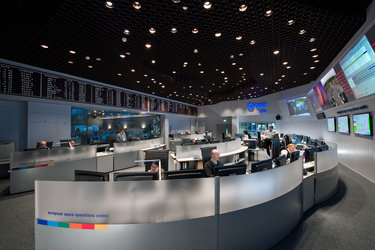Helping China to the Moon
Shortly after China’s Chang’e-3 spacecraft departs Earth to land on the Moon, ESA’s network of tracking stations will swing into action, providing crucial support for the vessel’s five-day lunar cruise.
China’s Chang’e-3, named after the mythological goddess of the Moon, is scheduled for lift off on 1 December from the Xichang launch base in China’s Sichuan province on a journey to deposit a lander and a six-wheeled rover on the lunar surface.
The landing, in the Sea of Rainbows on 14 December, will be the first since Russia’s Luna-24 in 1976.
Immediately after liftoff, ESA’s station in Kourou, French Guiana, will start receiving signals from the mission and uploading commands on behalf of the Chinese control centre.
The tracking will run daily throughout the voyage to the Moon. Then, during descent and after landing, ESA’s deep-space stations will pinpoint the craft’s path and touchdown.

“We are proud that the expertise of our ground station and flight dynamics teams and the sophisticated technologies of our worldwide Estrack network can assist China to deliver a scientifically important lander and rover to the Moon,” says ESA’s Thomas Reiter, Director for Human Spaceflight and Operations.
“Whether for human or robotic missions, international cooperation like this is necessary for the future exploration of planets, moons and asteroids, benefitting everyone.”
The effort is being run from the Estrack Control Centre in ESA’s European Space Operations Centre in Darmstadt, Germany.
Following lunar mission progress
Chang’e-3 liftoff is set for around 18:00 GMT on 1 December, and the 15 m-diameter dish in Kourou will pick up the first signals around 18:44 GMT.

Working with Chinese tracking stations, Kourou will support the mission through lunar orbit entry on 6 December continuing until just prior to its descent to the surface, expected around mid-day on 14 December.
The landing and rover operations on the Moon will be commanded via two Chinese tracking stations at Kashi, in the far west of China, and at Jiamusi, in the northeast.
“After the lander and rover are on the surface, we will use our 35 m-diameter deep-space antennas at Cebreros, Spain, and New Norcia, Australia, to provide ‘delta-DOR’ location measurement,” says Erik Soerensen, responsible for external mission tracking support at ESOC.
“Using this delta-DOR technique, you can compute locations with extreme accuracy, which will help our Chinese colleagues to determine the precise location of the lander.”
Cebreros and New Norcia stations watch lunar landing
Together with Cebreros, New Norcia will record Chang’e-3’s radio signals during landing, which will help the Chinese space agency to reconstruct the trajectory for future reference.
A team of engineers from China will be on hand in Darmstadt. “While we’re very international at ESOC, hardly anyone speaks Mandarin, so having Chinese colleagues on site will really help in case of any unforeseen problems,” says Erik.
“Both sides are using international technical standards to enable our stations and ESOC to communicate with their mission and ground systems."















 Germany
Germany
 Austria
Austria
 Belgium
Belgium
 Denmark
Denmark
 Spain
Spain
 Estonia
Estonia
 Finland
Finland
 France
France
 Greece
Greece
 Hungary
Hungary
 Ireland
Ireland
 Italy
Italy
 Luxembourg
Luxembourg
 Norway
Norway
 The Netherlands
The Netherlands
 Poland
Poland
 Portugal
Portugal
 Czechia
Czechia
 Romania
Romania
 United Kingdom
United Kingdom
 Slovenia
Slovenia
 Sweden
Sweden
 Switzerland
Switzerland




































